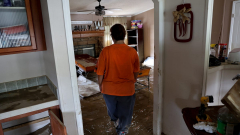Kentucky’s historic floods, amid rising extreme weather in the U.S., have fueled fears that more frequent and severe flooding could be in store for Appalachia, one of America’s most vulnerable regions. While some residents are fatalistic, others are calling for more measures to mitigate flooding.

JACKSON, Ky. — Teresa Watkins worked to salvage a few mud-caked belongings from her home on a Breathitt County branch of the Kentucky River after July 28 floods slammed her neighborhood for the second time in 17 months.
The 54-year-old, who has lived off Quicksand Road since she was a teenager, said the flooding in recent years – “more and more, worse and worse” – has left difficult dilemmas in a county where median household incomes of $29,538 are less than half the national average.
She pointed to a mobile home one family abandoned last year. Now, more say they’re leaving for safer areas, she said, but it’s not that easy.
“I don’t know how they can afford it, or where they’re going to go. Any property is basically along the river line or creek banks,” she said. “And if they go up on the mountains, the mountains slide.”
‘I CAN’T GET OUT’: As historic flooding raged, Kentucky woman survived by binding herself to her kids with vacuum cord
Devastating floods that killed at least 37 people in Kentucky and recent damage in other parts of Appalachia, including Virginia and West Virginia, are fueling urgent questions about how to mitigate the impact of hazardous flooding that is only expected to increase as climate change fuels more extreme weather.
But in one of America’s most economically depressed regions, there are few easy answers.
The region’s mountainous landscape, high poverty rates, dispersed housing in remote valleys, coal-mining scarred mountains that accelerate floods and under-resourced local governments all make solutions extremely difficult.
Measures such as flood wells, drainage systems or raising homes are expensive for cash-strapped counties. Buyouts or building restrictions are difficult in areas where safer options and new home construction are limited. Many are unable or unwilling to uproot.
And tamping down extreme weather by reducing climate-changing emissions nationwide is a goal that is politically fraught, including in a region with coal in its veins, that promises no quick relief.
“If we had all the money in the world, and we had the political will and cooperation, we could go a long way towards solving these problems,” said William Haneberg, director of the Kentucky Geological Survey and a professor of Earth & Environmental Sciences at the University of Kentucky.
Even as Kentucky’s devastation renews attention to longstanding challenges, some residents say they have little hope that effective protections will arrive anytime soon.
For now, the emphasis is on trying to rebuild what was lost. In Kentucky, Gov. Andy Beshear said recently that he may call a special legislative session for more aid to the region, and FEMA is providing housing and other help.
CLIMATE POINT: Subscribe to USA TODAY’s free weekly newsletter on climate change, the environment and the weather
Still, repeat floods have prompted some officials to search for longer-term answers. Buchanan County, Virginia, for example, is drawing up a flood-resiliency plan to identify projects to blunt flooding’s impact. But those projects would still have to be paid for.
Some residents are fatalistic or doubt the government can do much. Others are pushing for more protections in areas where many have few options to move and can’t afford flood insurance.
In the Buchanan County community of Pilgrim’s Knob, Sherry Honaker, 55, this week watched crews remove debris from her niece’s home on Dismal Creek. It was gutted in a major flood about two weeks before the Kentucky floods – the county’s second this year.
“Something needs to be done,” she said.
How susceptible is Appalachia?
Central Appalachia is no stranger to flooding. But the latest high water in Eastern Kentucky was record-breaking, and experts expect more to follow.
Amid the larger pattern of extreme weather in the United States, from wildfires to heat waves, meteorologists and climate scientists say human-driven climate change comes with a warmer atmosphere capable of holding more moisture.
That can mean more bouts of intense rainfall, and more rain in a short period of time fuels flash flooding, said Antonia Sebastian, an assistant professor at the University of North Carolina at Chapel Hill specializing in flood resilience and mitigation.
The region’s topography also contributes to how “flashy” a flood can be, Sebastian said.
The steep slopes of the Appalachians allow water to rush quickly into the narrow valleys below, sometimes swamping hollows before residents have a chance to escape.
In 2019, an Inside Climate News analysis of U.S. Army Corps of Engineers streamflow data and satellite images of disturbed land from strip mining found areas such as the Big Sandy watershed, which straddles the Kentucky and West Virginia state line, to be among the most threatened by climate-change-fueled extreme weather within the Ohio River Basin.
The region’s history of coal mining, as well as logging, can exacerbate flooding, experts said, by dramatically altering the landscape.
With surface mining, trees are the first to go, then sometimes hundreds of feet of rock are blasted away from the tops and sides of mountains to get at underground seams of coal.
“Normally, on a forested hillside, the trees and their roots will absorb 40% to 50% of the rain that falls, then slowly release it,” said Jack Spadaro, a former top federal mine safety engineer. After mining, surfaces robbed of vegetation help fuel flash flooding, he said.
INFLATION REDUCTION ACT: What you need to know about major effort to fight climate change
Housing patterns also contribute to the area’s vulnerability, with many residences scattered in smaller communities along a road that often winds along a creek lined with steep hillsides.
In Kentucky’s Breathitt County, for example, half of all homes are at a high risk of flooding, according to data provided to USA TODAY by the First Street Foundation, a research and technology nonprofit that tracks flood risks.
The same is true of 46% of homes in Perry County and 58% in Letcher County.
“You hear people say, ‘Oh, you know, they shouldn’t live in a floodplain. They should move someplace else.’ But if you look at a lot of these towns, there are really not a lot of good options,” Haneberg said.
Added to that is the area’s economic vulnerability. Many residents cannot afford flood insurance.
Amid coal’s decline, good jobs are hard to find. Breathitt County’s poverty rate is 28%, more than twice the national rate of 11%. The median home value of $53,000 is less than a quarter of the national average, according to the U.S. Census.
The region has higher rates of chronic disease and populations that have fallen in recent decades.
Jessica Willett, 34, whose remote Jackson home was pushed downstream by flooding while she and her two children were inside, said she was nervous about rebuilding on Bowling Creek.
But it’s also a home she doesn’t want to leave.
“My aunt down the road, she is going to move. She lost everything,” she said. “It’s just hard because down here, there’s a lot of family land. We want our kids and grandkids to grow up on it.”
The ‘pain points’ of climate change
Standing near Dismal Creek in Virginia, Honaker looked over a giant pile of rubble. She said she wants officials to ramp up unclogging draining culverts or increasing the creek’s depth.
She looked at her niece’s home: “Maybe stilts would have helped,” she said.
While it’s impossible to halt heavy rains and flooding, counties and t





